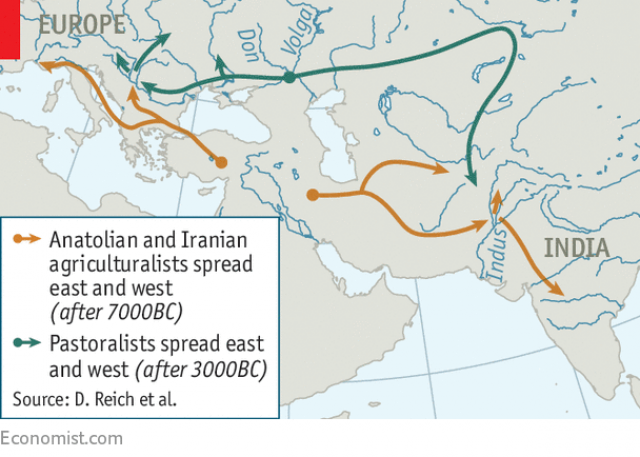A CENTURY and a half ago linguists invented a new map of the world. Their research showed that
a single family tree stretches its branches almost unbroken across most of Eurasia: from Iceland to Bangladesh, most people speak languages descended from "Proto-Indo-European". The philologists had a theory to explain why Sanskrit, the ancient forebear of Hindi, has closer cousins in Europe than in south India. They speculated that at some point before the composition of the Vedas, the oldest texts of Hinduism, an Aryan people had migrated into India from the north-west, while their kin pushed westward into Europe.
Long before the Nazis dreamed of an exalted master race, imperialists seized on what some dubbed the "Aryan invasion" theory to paint Britain's rule of India as the extension of a "natural" order. Indians, too, found a use for it. Caste-bound Hindu conservatives declared that the paler-skinned intruders must be ancestors of higher-caste Brahmins and Kshatriyas. Such talk stirred a backlash in southern India, where generally darker-skinned speakers of Dravidian languages were urged to see themselves as a separate nation.
Hindu nationalists took a different tack. The West, some said, had made up the theory to set Hindus against each other. Christian missionaries and communists were using it to stoke caste hatred and so to recruit followers, they claimed. Worse, the theory challenged an emerging vision of Mother India as a sacred Hindu homeland. If the first speakers of Sanskrit and the creators of the Vedas had themselves been intruders, it was harder to portray later Muslim and Christian invaders as violators of a purity that good Hindus should seek to restore. So it was that some proposed an alternative "Out of India" theory. This held that the original Aryans were in fact Indians, who carried their Indo-European language and superior civilisation to the West.

Yet, even as Hindu nationalism has gained politically, culminating in the current rule of the conservative Bharatiya Janata Party (BJP), evidence has mounted against the out-of-India hypothesis. Philologists have determined with a fair degree of certainty that
the Vedas were probably composed between 1500BC and 500BC. Archaeology, meanwhile, indicates that a sophisticated urban civilisation had flourished in the Indus Valley around a thousand years earlier, but had collapsed before the Vedic Age.
The culture depicted in Sanskrit texts has different traits.
It was largely rural and pastoral, relied on iron instead of bronze and appears to have used horses, chariots and bows and arrows-all of which are absent from the original Indus settlements. Proponents of the Aryan invasion conclude that a large influx of outsiders would neatly explain all this. Another clue: the proportion of Indians who can tolerate cows' milk decreases markedly towards the east, suggesting that cattle-herders migrated into the country from the west.
Even so, fierce exchanges in Indian social media have greeted every new study. Academic researchers have found themselves branded Christian missionaries, "sickularists" or even Chinese agents. Lately, however, such controversy has shifted from linguistics and archaeology to genetics. As techniques of extracting, analysing and tracking DNA through time and place improve, a clearer picture is emerging.
An accumulating pile of research using DNA from both ancient human remains and modern people indicates strongly that, beginning around 2000BC, north-west India was indeed infused with new blood. The newcomers appear to have shared the same roots in what is now southern Russia as did the invaders of a similar-sized peninsula to the west called Europe. Strikingly, too, the genetic markers identifying this group seem to be far more prevalent among modern north Indian Brahmins than among other Indians.
Because of the difficulty in collecting ancient DNA, such research has until recently relied on relatively few samples. But an international team of 92 scholars, including David Reich, a geneticist at Harvard University who has pioneered techniques to analyse DNA more quickly and precisely, is set to publish
data recovered from 362 "ancient individuals" from across South and Central Asia. Among their conclusions: there was probably an early migration of agriculturalists into India from what is now Iran, around 4000BC, and this was followed two millennia later-just before the Vedic Age-by a large influx from what is now southern Russia (see map).The wider study not only confirms that "Aryans" (geneticists avoid the term)
probably migrated from the steppes around the Volga and Don rivers to both India and Europe at around the same time. It also shows that their genetic markers later spread southwards across India, and are indeed particularly prevalent in "groups of priestly status".This article appeared in the Asia section of the print edition under the headline "Steppe sons"
A few weeks a go, I visited a prehistorical museum in north eastern Germany. And there I learned about the excavation place of a battle at about 1300 BC, here [Link] The numbers are already outdated (or falsified by Wikipedia), current estimates assume more than 6.000 dead, and more than 10.000 combattants on each side. How got that many people to fight in an area of (supposedly) endless forests and swamps, and more important, what were they fight about, in the middle of nowhere ? Compare this to "epic battles" in the same period described in biblical history, with all the archeological evidence missing.
So, it should come as no surprise that excavations are currently at halt, because of lack of funding. That couldn't be politically motivated ...